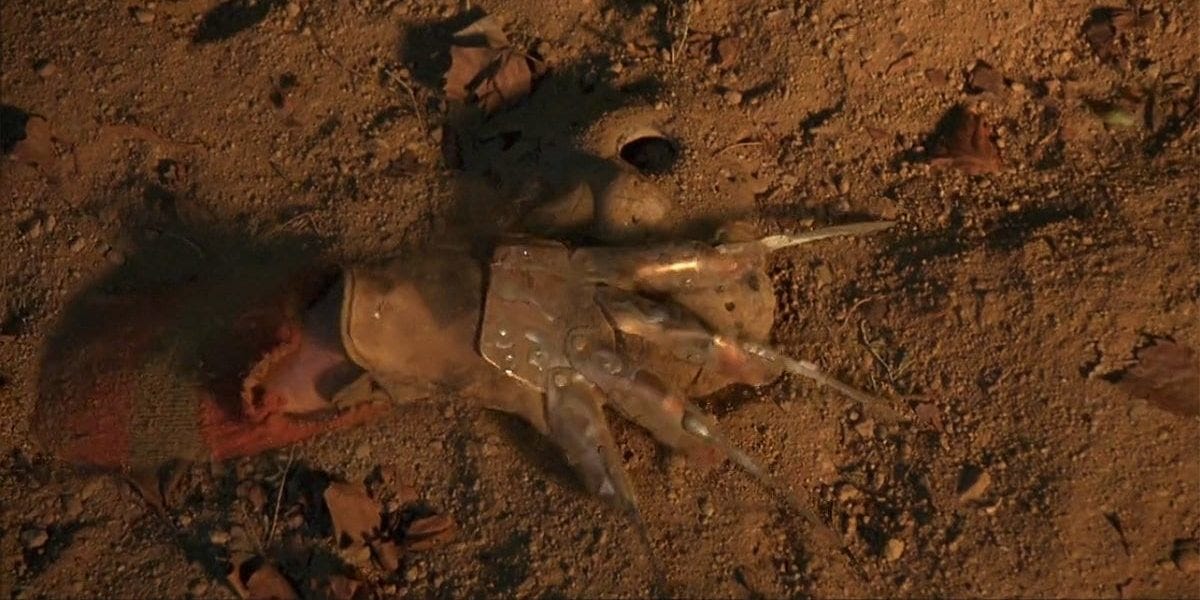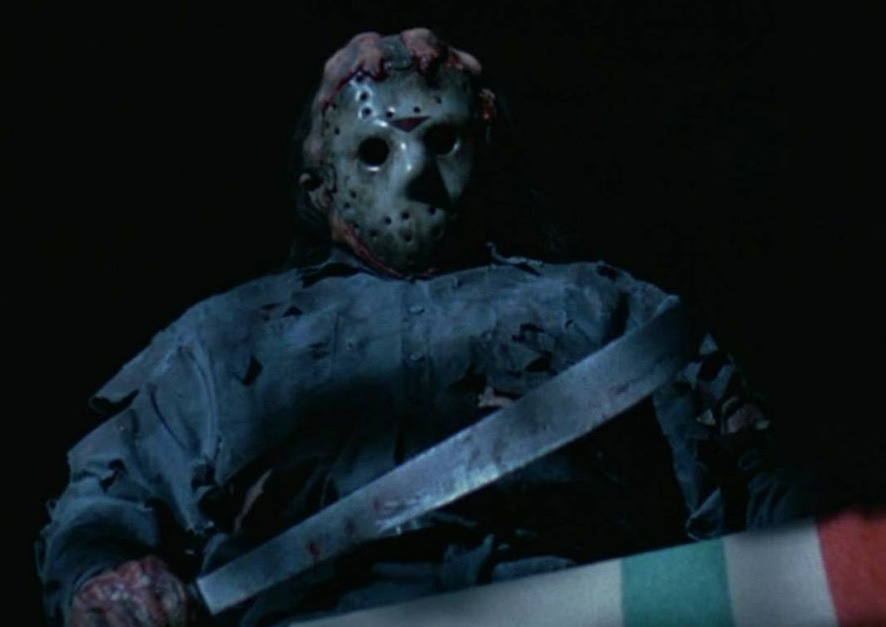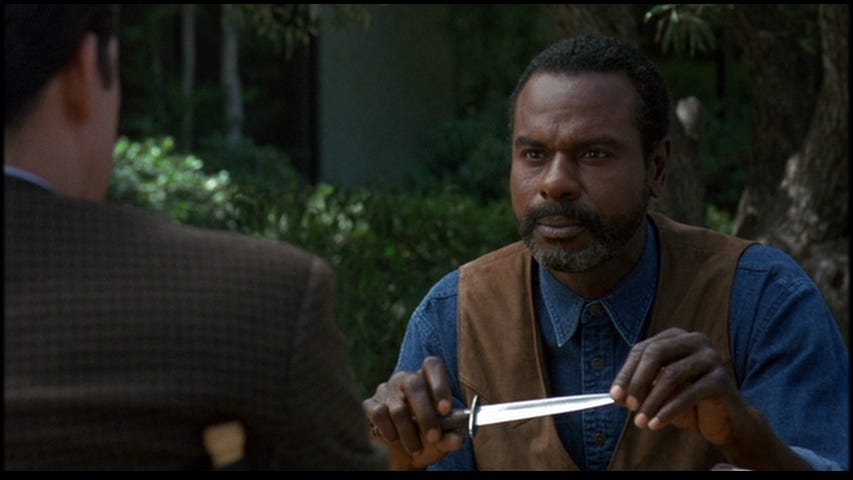Summer of 1993: Jason Goes to Hell - The Final Friday
Even for the low bar of the Crystal Lake chronicles, this one sucks.
About 20 years ago, right around Halloween, I was at Target when I stumbled on what I thought was a great deal: a boxed set of all of the Friday the 13th movies was on sale for a price I could afford (in hindsight, I still wouldn’t call $60 a great price). I picked it up, took it home and announced to my roommate that I had our next few nights of entertainment covered.
It was the worst financial decision I ever made (and I once spent $2,160 on a video dating service). We made it through about three of the movies before declaring ourselves done with Jason Voorhees, and I think I ended up hawking the boxed set for like $15 at a resale place a few months later. The movies were insipid, cheap and sleazy, and I couldn’t picture myself ever revisiting the series.
My weird fascination with Jason Voorhees
Proverbs says a fool will repeat his mistakes like a dog returning to its own vomit. And while I’ve never shelled out money to repurchase the Friday the 13th series, I’ve retained a weird fascination with the butcher of Crystal Lake. I wrote about part two for a slasher series a few years back. I once sat down and watched the entire seven-hour documentary Crystal Lake Memories over the course of a week. And I can’t lie that I’ve seen the Shout! Factory boxed set – different from the set I mentioned earlier, because it features bonus features and three more films – and thought “you know…maybe.”
There’s a weird nostalgia I have for Friday the 13th that has less to do with the films themselves so much as the iconography of Jason Voorhees and the crass yet dependable pleasures that came from watching the films as a kid. I was fascinated by the hockey mask-clad slasher, who lacked the supernatural and creative appeal of Freddy Kreuger but brought a brutality and trashiness that Michael Myers and his films lacked. A few weeks back, I was at a local comic book convention that featured Tom Savini, the special effects maestro for the first Friday the 13th, and I couldn’t help but smile as I thought about him putting an arrow through Kevin Bacon’s throat. There was something about the Friday movies that was transgressive, and it was a pull that still appealed to me in my 20s. I couldn’t say the films were art or had the creative appeal of A Nightmare on Elm Street or the subtext of Halloween – and that was their appeal. There was a guilty thrill in knowing these were trashy movies where you watched nubile young actors scream in the woods as a special effects team giddily indulged their grotesque imaginations. Some of my favorite Saturdays involved sneaking away to watch our local syndicated station play these movies as I watched through my fingers.
And I wasn’t alone. The Friday the 13th franchise was huge in the 1980s, making millions on the annual releases, even as the casts and crews gamely admitted that the movies were silly, logic-free rip-offs of better movies. In the 1980s, most Friday the 13ths saw the release of a new film in the franchise in theaters, and Jason joined Freddy as one of the decade’s most identifiable big-screen icons.
But by the early 1990s, the bloom was off the rose. Slasher movies just weren’t a powerhouse at the box office anymore. New Line Cinema had already killed off Freddy two years prior (don’t worry; Wes Craven would bring him back in 1994), and by 1993, there hadn’t been a Jason film since 1989’s Friday the 13th Part VIII: Jason Takes Manhattan, largely acknowledged as the nadir of the series, which brought in a paltry $14 million at the box office (on a $5 million budget, I’m sure Paramount wasn’t too upset).
Sean Cunningham, who hadn’t been involved with the series since the first film, hit upon the idea of a slasher team up pitting Jason against Freddy in a battle of the terror titans, an idea that was commercially conceivable since Elm Street studio New Line Cinema had negotiated the rights to Jason (Paramount kept the Friday the 13th title, which is why it isn’t used here). But New Line wasn’t quite ready to pit Freddy and Jason against each other just yet (and wouldn’t be for another decade; I highly recommend the book Slash of the Titans for the fascinating history of what would become Freddy Vs. Jason), and requested Cunningham come up with a placeholder idea to keep Jason in the public consciousness. The big idea? Send Jason to Hell.
A hellish experience
The film actually starts with an all-timer of a cold opening, as a young woman heads up to her cabin at Crystal Lake only to have her shower interrupted by the mask-wearing maniac. First-time director Adam Marcus clearly understands the tropes of the series – the lights that mysteriously go out, the anticipation of Jason appearing in dark corners, the completely gratuitous nudity – and he has a great time letting them play out in the film’s first few minutes. It’s not long before the young woman, clad in a towel, is being chased into the woods by Jason. But this time, there’s a wrinkle: the woman, actually an undercover agent, ducks for cover and an assault team appears, pelting Jason with bullets before doing what every middle schooler had suggested since the series began and hitting him with a missile, blowing him to smithereens. It’s a fun, shocking and gnarly beginning that plays to what the series is known for before delivering the fun twist of seemingly killing Jason.
And then it completely abandons what anyone wants from the series.
I was aware of Jason Goes to Hell’s reputation as a not-great movie; I know many people consider it a franchise low point, trading for the bottom of the barrel with Jason Takes Manhattan. But I don’t think anyone properly prepared me for how what was supposed to be a grand send-off completely whiffs on delivering even most of the guilty pleasures this franchise offers.
The Friday the 13th series is known for one thing: Jason Voorhees lumbering around the woods killing horny, stoned teenagers in increasingly gruesome fashion. The hockey mask – which Cunningham allegedly hated – is the series’ identity. The trope of Jason moving slowly through the woods but somehow still gaining on his prey is silly, but it’s part of the franchise. Old men muttering “you’re doomed,” unlikable teens being dismembered, people dismissing any warnings about Jason before running headfirst into a machete might not be art, but they’re what kept people coming back to theaters.
Jason Goes to Hell leans into this in its prologue and then turns into a weird and idiotic possession movie that makes less sense the longer the film goes on.
Interspersed with the film’s unending opening credits – during which original composer Henry Manfredini sonically bludgeons us with synthesizers – we watch a coroner (Richard Gant) take apart the pieces of Jason before fixating on his giant, pulsating heart (in an inversion of the Grinch story, we learn Jason's heart is two sizes too big), which is flowing over with black ooze. Hypnotized, he picks up the heart and takes a bite, becoming instantly possessed by the spirit of Jason. The film then follows Jason’s soul as it passes from person to person – never once looking like Jason except in fleeting reflections – as the killer seeks a family member from whom he can be born again. We learn Jason has a sister, who’s daughter and child are returning to Crystal Lake
I can’t imagine why anyone thought this was what the franchise’s dwindling fanbase wanted to see. Hulking Jason, in his jumpsuit and hockey mask, is the sell, and it takes away from the fun to have the killings be done by regular-looking people. The series was no stranger to the supernatural – Jason was resurrected with a lightning bolt in one entry and also faced down a psychic final girl – but the introduction of evil worms that pass Jason’s soul from body to body ladle way too much mythology into a franchise for which consistency was already laughable. And there’s too much plot for this movie to handle; on top of Jason’s kin and a new way for him to move from body to body, there’s the story of Jason’s niece and her baby returning to town, alongside a sleazy tabloid journalist eager to capitalize on the recent killings. There’s also a group of regulars at a greasy spoon diner (including Leslie Jordan!) who exist only for machete fodder, and a studio-mandated sequence with a random group of teens that allows us to briefly revisit Crystal Lake just so there’s some of the old DNA crammed in (to be fair, this sequence gives us the film’s best kill) before we never return to the camp.
I suppose a new direction would have been interesting had it brought anything creatively to the table that the series was lacking before. But the acting is just as one-dimensional, the filmmaking just as inept and the pacing just as inconsistent as any of the other Fridays. At least when Wes Craven took Freddy Kreuger in a new direction for New Nightmare, he brought a skillset and intelligence that invigorated a franchise on the decline; Jason Goes to Hell is just as poorly made as any film in the series, but it also lacks any of the familiarity that made them fun in spite of themselves. Even the much-lauded returns of Cunningham and Manfredini work against it. Producer Cunningham so obviously hates what Jason had become that he keeps him off the screen aside from the film’s beginning and end – why, when Jason is reborn, does he reappear as his battle-damaged, mask-wearing self instead of an infant or a man in his prime? And Manfredini’s original score, with its ki ki ki ma ma ma is iconic; but Jason Goes to Hell uses it only in the beginning, and then just hits us over the head with synths for the rest of the run time.
I will give credit where due – the makeup effects by KNB are truly outstanding. In the few moments where Kane Hodder appears as Jason, he has a great look, with the hockey mask nearly blending into his face and the back of his head so misshapen it looks like a wad of chewed gum. And the kills are gruesome, maybe some of the grossest in the series. There’s a young woman cleaved in two mid-coitus that is one of the most shocking things I’ve seen in a slasher, and the film lingers on the slow melting of a formerly possessed killer to give him an impressive death. The kills are brutal and gross, particularly in the unrated cut (which I believe is the only one available to stream), and gore hounds will be sufficiently impressed, which would have meant something to me 20 years ago but just seems tiring at middle age.
And I haven’t even gotten to the film’s best performance – and biggest missed opportunity.
We need to talk about Creighton
Early in the film, shortly after the FBI explodes Jason, the film cuts to an unseen observer dressed in a cowboy hat. While everyone is celebrating the killer’s apparent demise, he just chuckles and says “I don’t think so.”
We soon learn that this man is Creighton Duke, a bounty hunter with a specialty in killing serial killers. Played by Steven Williams, it’s a fun performance and presents an interesting wrinkle in the mythology – what if there was someone tracking Jason and training to take him down.
But Duke’s an incoherent character – and not just because when he’s asked to describe Jason Voorhees, he offers some nonsense about a young girl shoving a hot dog through a donut (the screenwriters apparently had no idea what this meant, either; they just thought it was funny). Sometimes Creighton seems to be a driven, obsessive man doing the right thing; other times, like when he breaks the protagonist’s fingers just for the hell of it or verbally sexually assaults another protagonist, he’s just a jackass. The film briefly hints that he may have a past history with Jason, but never follows up on it. Instead, he’s just an exposition machine, doling out information about body-hopping demons, weird rebirth rituals and magic knives.
Here’s the thing: there’s a great idea for Creighton Duke that either no one considered or the studio wouldn’t allow, and it leads to a big missed opportunity.
Jason Goes to Hell desperately wants to be a crossover film, an MCU event for horror before the MCU was even a thing. The film started with Cunningham wanting to do a Freddy vs. Jason movie, and even though it would be a decade before that happened, the movie does end with Freddy’s gloved hand pulling Jason’s mask to hell (after a pair of what I can only describe as Muppet hands pulled his body there). And when the heroes visit the Voorhees house (which no one has mentioned before and is apparently still preserved a decade into the series), they see the Necronomicon from Evil Dead … and not just a similar book; Raimi lent the filmmakers the actual Necronomicon from his films, and the movie lingers on its pages.
So I kept thinking somehow it would be revealed that Creighton Duke was a bounty hunter who specialized not just in catching serial killers but the biggest, most monstrous fiends from horror movies. Maybe he’d just come back from Texas bringing down Leatherface. Maybe a sequel would have seen him hunting down Freddy and unwittingly causing a partnership between Kreuger and Jason. Maybe he’d need the help of Ash. There were endless possibilities, especially since at this time New Line owned Freddy, Jason and Leatherface (and the rights for Evil Dead have constantly bounced around).
But no; Creighton’s just another weirdo who, in the end, has his back smashed by Jason. And the film is just another dumb Friday the 13th with a ‘90s action movie gloss. It’s boring, badly made and stupid, and without the fun of the earlier films. And it was a disappointment at the box office, becoming the second-lowest grosser of the franchise. It would be eight years before Jason Voorhees showed up on the big screen again – in the similarly dumb but much more fun Jason X – and even longer until he actually crossed knives with Freddy Kreuger.
But at least in those movies, we got to see a lot of the mask.








